HILO — It’s been 140 years since the first Portuguese immigrants arrived in Hawaii, but their legacies are being remembered through the memories of their descendants.
Jackie Pualani Johnson has interviewed some of these descendents in East Hawaii to capture their values and lifestyles, turning their words and memories into living history performance pieces.
She spoke at the beginning of the month to a group from Kamana Senior Center about her efforts.
Johnson told the crowd that there has been a lot of excitement about the under-construction Hawaii Island Portuguese Chamber of Commerce Cultural and Educational Center.
“It’s going to be a place that will celebrate the Portuguese culture, but will also be a chance to celebrate us in terms of our living history,” she said. “And that’s how I’m getting involved in this because I love taking living history, oral ‘talk story kine,’ and putting (it) into performances. And that’s basically what today will be about.”
With her presentation titled “The Journey Continues,” Johnson said it was called that “because 140 years ago the Portuguese came here, but the influence is still so wonderful.”
The S.S. Priscilla arrived in Honolulu Harbor from Funchal, Madeira on Sept. 30, 1878, carrying Hawaii’s first Portuguese immigrant families, who came to work on the sugar plantations as contract laborers.
Two living histories that have been performed with live actors feature the stories of Dolores Tavares and Nobert and Erma Serrao.
“Norbert and Erma Serrao were the people who I sat with outside Starbucks — at Prince Kuhio Plaza — for hours, you know, drinking coffee, (with) the telephone tape recorder running and my computer, and we talk story,” Johnson said. “Basically, that’s what it’s all about. It’s my job to get the information from them and then, as a performer, what I like to do is take the leap where I take some themes and put it together as though it’s a script.”
After hours of visiting and talking, Johnson said she went home, transcribed the conversations, “and then I gleaned what I wanted for the actual performance,” tying ideas together through their perspectives.
“Living history is not necessarily genealogy,” Johnson said. “The facts will be there very often, but it’s a perspective — it’s through their eyes how they want their lives to be captured and shared.”
Johnson shared a portion of those pieces, recorded with actors, at the lecture. Throughout, audience members whispered about familiar names, faces and neighborhoods.
She also shared tips on how to research and gather oral histories.
As a researcher, Johnson said the only active role she had was to listen.
“I wasn’t manipulating information. I wasn’t trying to get them to fess up to anything or to go in a certain direction. But I did ask questions, so that’s where it all comes.”
Johnson said after the lecture that she was asked previously to do a one-woman show about Queen Emma, which led to histories of other monarchs.
“Then it was almost like a natural progression to doing things about people in general in Hawaii,” she said. “But for me, the oral history is the most meaningful and that’s why I’m continuing with that since I’ve retired.”
Capturing these histories “dignifies existence,” Johnson said.
“Who are we if we don’t understand what happened before, how we’re related to each other now and what the future is going to be?” she said. “That’s a very Hawaiian perspective to the past, the present, the future — all one. So I think we’re influenced by that, but there’s something about feeling like your feet are on the ground.”
Email Stephanie Salmons at ssalmons@hawaiitribune-herald.com.



